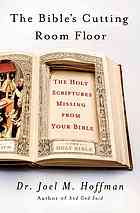
The Bible's Cutting Room Floor
The Holy Scriptures Missing from Your Bible
کتاب های مرتبط
- اطلاعات
- نقد و بررسی
- دیدگاه کاربران
نقد و بررسی

August 11, 2014
Hoffman (And God Said: How Translations Conceal the Bible’s Original Meaning) leads the reader through the Pseudepigrapha and related writings left out of the biblical canon. Through his summaries and analysis, he ably demonstrates why these “second tier” works—some of them not included in the official biblical canon for their controversial theology, and others for purely practical reasons—should not be ignored. They shed crucial light on our understanding of the books of our “official” Bible, as well as being themselves worthy sources for seekers of theological, and philosophical, meaning. Hoffman also provides an accessible and entertaining history of the context in which the “rejected” works arose, a fascinating account of how the Dead Sea Scrolls came to light in the mid-20th century (and what they include), an analysis of Josephus’s contributions to history, and the relationship between the Septuagint (the Greek translation of the Bible) and the Hebrew Scriptures. As the book is but a taste of extracanonical riches, it accordingly includes an appendix with recommended additional reading. Agent: Irene Goodman, Irene Goodman Literary Agency.

August 1, 2014
Translator and Jerusalem Post contributor Hoffman (And God Said: How Translations Conceal the Bible's Original Meaning, 2010) explains biblical stories by revealing lost passages, making them more understandable and plausible to modern readers. The author's knowledge of ancient languages shows early on, and he demonstrates how easily words can be mistranslated and entire meanings altered. Furthermore, a translator might alter a passage to make it more politically appropriate or relevant to the times. As Hoffman notes, there are anywhere from 33 to 78 books that could have been included in the Bible ("The Bible you usually read is an abridged version...culled from a much larger selection of holy scriptures when new realities forced religions leaders to discard some of their most cherished and sacred books"). All of them ask timeless questions and offer different insightful answers about good and evil and the human condition. The author explores the Dead Sea Scrolls, 2,000-year-old documents discovered in a cave by goatherds in 1947; the Septuagint, a translation from Hebrew to Greek ordered by Ptolemy II in the third century B.C.; and the A.D. first century writings of the Jewish historian Josephus. Hoffman examines not only where they agree and where they vary from our modern Bible, but also the wealth of material that was left out. This is where the author shines as he explains that the Tower of Babel was built to protect against another great flood and gives the truth about Herod and Pilate. During the upheavals of the first century, many groups struggled to make sense of the changing times, and Christianity and Rabbinic Judaism are among those systems of belief that endured. A wonderful book to confirm the beliefs of the faithful, to strengthen those whose faith begs for more information and to enlighten those who reject the stories of the Bible as mere fiction.
COPYRIGHT(2014) Kirkus Reviews, ALL RIGHTS RESERVED.

September 15, 2014
There is no shortage of books examining the Bible as a historical document. Yet while many seek to simply refute or support biblical claims, Hoffman's (And God Said) latest work aims to do much more. The author uses historical documents and apocryphal material to piece together what has been omitted from the Bible and to provide context for the stories and messages that were included. He maintains that the Bible has been edited--multiple times, by people with varying motives--and uses his own study of the work and religious history to fill in the blanks. He does not mince words, delving directly into events that surrounded the writing of biblical texts, including some of the most well-known accounts such as what happened after Adam and Eve left the garden and what led Abraham to father a nation. Hoffman provides a bevy of insights as to why the Bible may have been abridged in a thorough, pointed style that will greatly appeal to amateur historians and biblical scholars. VERDICT A much needed supplement for people wishing to study biblical history and a great place to start for those interested in learning more about ancient texts and peoples.--Kathleen Dupre, Edmond, OK
Copyright 2014 Library Journal, LLC Used with permission.

September 1, 2014
Where were Adam and Eve after Eden but before Cain and Abel? How did Abraham come to embrace monotheism? Why didn't Noah's grandfather Enoch ever die? The Bible would be a more satisfying narrative if it answered such questions. That it doesn't is due to accidents of compilation, Hoffman says, as the greatest discovery of modern biblical scholarship, the Dead Sea Scrolls, confirmed more amply than ever before. Besides those momentous artifacts, the history of Jerusalem; the Septuagint, the third-century BCE first Greek translation of the Hebrew Bible; and the first-century CE writings of Josephus, so important for New Testament studies, allow filling in the gaps and solving the riddles in the canonical Old Testament. Moreover, the stories of our first parents, the original monotheist, and the man who never died have existed in extracanonical scriptures known for centuries. Rather breezily, yet carefully, Hoffman discusses all those sources of additional biblical information and, noting their shortcomings (e.g., the oldest Josephus manuscripts are centuries younger than he!), how they're used to solve biblical mysteries. An engrossing gift for amateur Bible students(Reprinted with permission of Booklist, copyright 2014, American Library Association.)

























دیدگاه کاربران